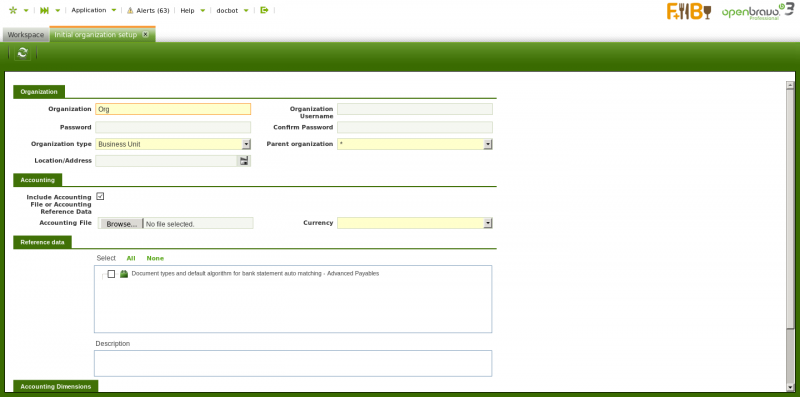Initial organization setup
| Back to General Setup |
Introduction
An Organization is an enterprise of a Client. A client can have at least one or even more than one organization as the way of configuring different types of enterprises models.
Overall organizations can be:
- independent legal entities with a different Tax ID number
- enterprise groups with the aim of getting aggregated figures for the group
- or business areas of the client such as departments
Besides organizations can be structured:
- by country or region
- by area or function
- and so on so forth, according to the enterprise model needs.
All of the above provides an insight about the different scenarios which need to be covered while modelling the enterprise.
There could be organizations which require to share master data such as business partners and product while having its own chart of account, taxes, financial reporting and transactional data. That could be the case of independent legal entities belonging to the same enterprise group.
There could be organizations sharing master data and even the same chart of accounts. That could be the case of divisions or departments within the same independent legal entity.
There could be organizations created with the aim of just grouping data, for which its own transactional data is not required.
All of the above is possible due to the fact that there are different types of Organizations, see below section, and besides organizations can be structured in a hierarchical way:
- At the highest level of the tree, there is an organization named (*).
- (*) organization is created at the same time that the system client is created, and it is shared among the different client/s in the system.
- Master data created at (*) organization level is accessible for all the organization beneath it
- (*) organization is not an independent legal entity therefore transactional data is not allowed.
- Every organization created later on will be created below (*) organization.
- At a lower level of the tree, there can be parent organization/s which can have child organization/s beneath it/them.
- Master data such as business partners and products created at parent organization level is accessible for all the child organization/s beneath it.
- At the lowest level of the tree, there can be child organization/s with no organizations beneath it/them.
- Master data such as business partners and products created at child organization level will not be accessible for the rest of the child organizations if any.
Initial Organization Setup
As already mentioned Organizations are created by running the Initial Organization Setup process and not only that, once an organization has been created it must be set as "Ready" in the Organization window
As shown in the image above an organization can be created by providing below relevant data:
- the name of the organization
- the name of the user of the organization
- Openbravo creates a new user and a new role which only have access to the newly created organization.
- This user can be later on changed by assigning new roles to it.
- And the role can also be later on changed by assigning new organizations to it.
- Openbravo creates a new user and a new role which only have access to the newly created organization.
- the organization type. The options available are:
- Organization - an organization which is not a legal entity and does not allow transactional data entering.
- This type of organization allows the creation and configuration of master data to be shared among a group of organizations of any type belonging to it, for instance Business Partners, Chart of Accounts, etc.
- It does not require general ledger as it does not allow entering transactions but it can have a given General Ledger Configuration to be shared among the organizations underneath
- The accounting periods can not be opened and closed independently at its level.
- And there could be as many organizations type "organization" in a branch as required.
- Legal with accounting - an independent legal entity with a unique Tax Id number which requires accounting, therefore:
- this organization requires General Ledger and therefore an Account Tree or Chart of Accounts, as well as a Fiscal Calendar because the accounting periods can and must be opened and closed at its level.
- This organization type allows the "consolidation" of the Balance Sheet and P&L reports only for the Chart of Accounts it has assigned.
- Organization - an organization which is not a legal entity and does not allow transactional data entering.
Transactions are allowed for this organization type.
- And finally, there can only be one legal entity per tree branch, therefore the organizations underneath inherit the General Ledger configuration and the Fiscal Calendar of the legal with accounting organization.
| Back to General Setup |
